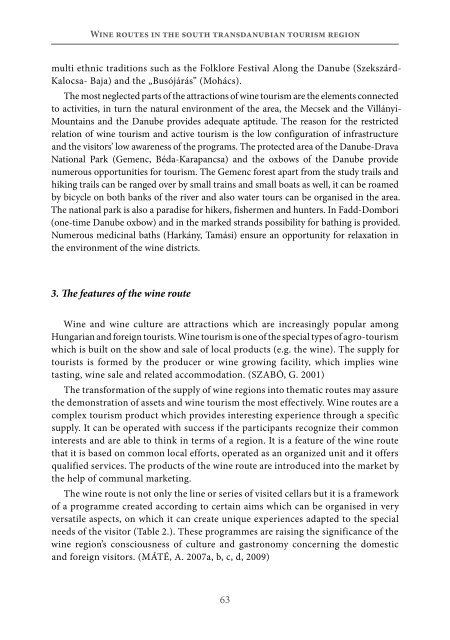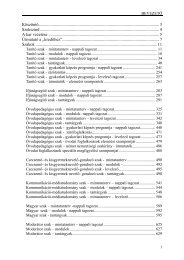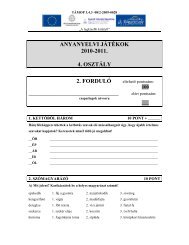ACTA SZEKSZARDIENSIUM - Pécsi Tudományegyetem Illyés Gyula ...
ACTA SZEKSZARDIENSIUM - Pécsi Tudományegyetem Illyés Gyula ...
ACTA SZEKSZARDIENSIUM - Pécsi Tudományegyetem Illyés Gyula ...
You also want an ePaper? Increase the reach of your titles
YUMPU automatically turns print PDFs into web optimized ePapers that Google loves.
Wine routes in the south transdanubian tourism region<br />
multi ethnic traditions such as the Folklore Festival Along the Danube (Szekszárd-<br />
Kalocsa- Baja) and the „Busójárás” (Mohács).<br />
The most neglected parts of the attractions of wine tourism are the elements connected<br />
to activities, in turn the natural environment of the area, the Mecsek and the Villányi-<br />
Mountains and the Danube provides adequate aptitude. The reason for the restricted<br />
relation of wine tourism and active tourism is the low configuration of infrastructure<br />
and the visitors’ low awareness of the programs. The protected area of the Danube-Drava<br />
National Park (Gemenc, Béda-Karapancsa) and the oxbows of the Danube provide<br />
numerous opportunities for tourism. The Gemenc forest apart from the study trails and<br />
hiking trails can be ranged over by small trains and small boats as well, it can be roamed<br />
by bicycle on both banks of the river and also water tours can be organised in the area.<br />
The national park is also a paradise for hikers, fishermen and hunters. In Fadd-Dombori<br />
(one-time Danube oxbow) and in the marked strands possibility for bathing is provided.<br />
Numerous medicinal baths (Harkány, Tamási) ensure an opportunity for relaxation in<br />
the environment of the wine districts.<br />
3. The features of the wine route<br />
Wine and wine culture are attractions which are increasingly popular among<br />
Hungarian and foreign tourists. Wine tourism is one of the special types of agro-tourism<br />
which is built on the show and sale of local products (e.g. the wine). The supply for<br />
tourists is formed by the producer or wine growing facility, which implies wine<br />
tasting, wine sale and related accommodation. (SZABÓ, G. 2001)<br />
The transformation of the supply of wine regions into thematic routes may assure<br />
the demonstration of assets and wine tourism the most effectively. Wine routes are a<br />
complex tourism product which provides interesting experience through a specific<br />
supply. It can be operated with success if the participants recognize their common<br />
interests and are able to think in terms of a region. It is a feature of the wine route<br />
that it is based on common local efforts, operated as an organized unit and it offers<br />
qualified services. The products of the wine route are introduced into the market by<br />
the help of communal marketing.<br />
The wine route is not only the line or series of visited cellars but it is a framework<br />
of a programme created according to certain aims which can be organised in very<br />
versatile aspects, on which it can create unique experiences adapted to the special<br />
needs of the visitor (Table 2.). These programmes are raising the significance of the<br />
wine region’s consciousness of culture and gastronomy concerning the domestic<br />
and foreign visitors. (MÁTÉ, A. 2007a, b, c, d, 2009)<br />
63




